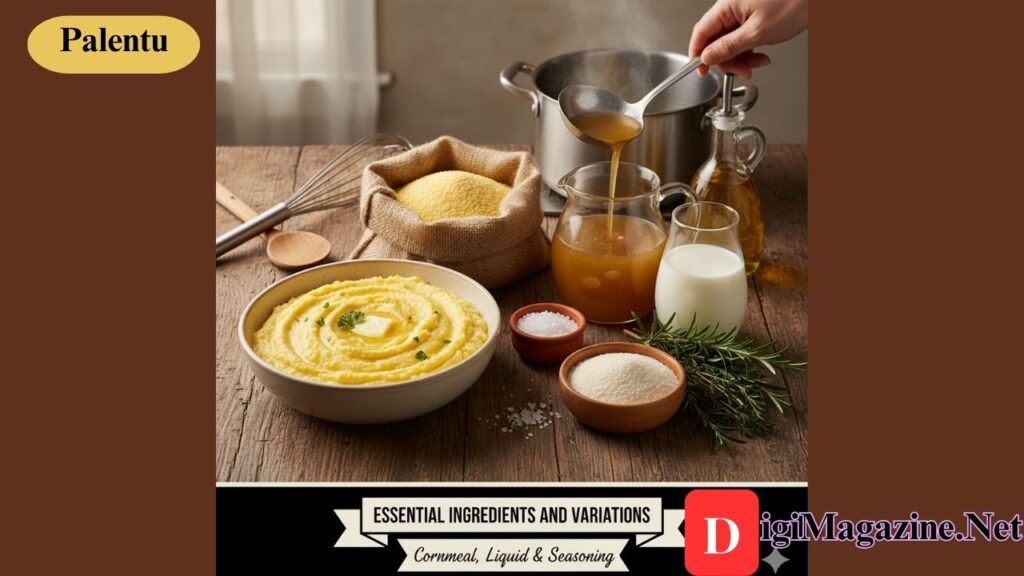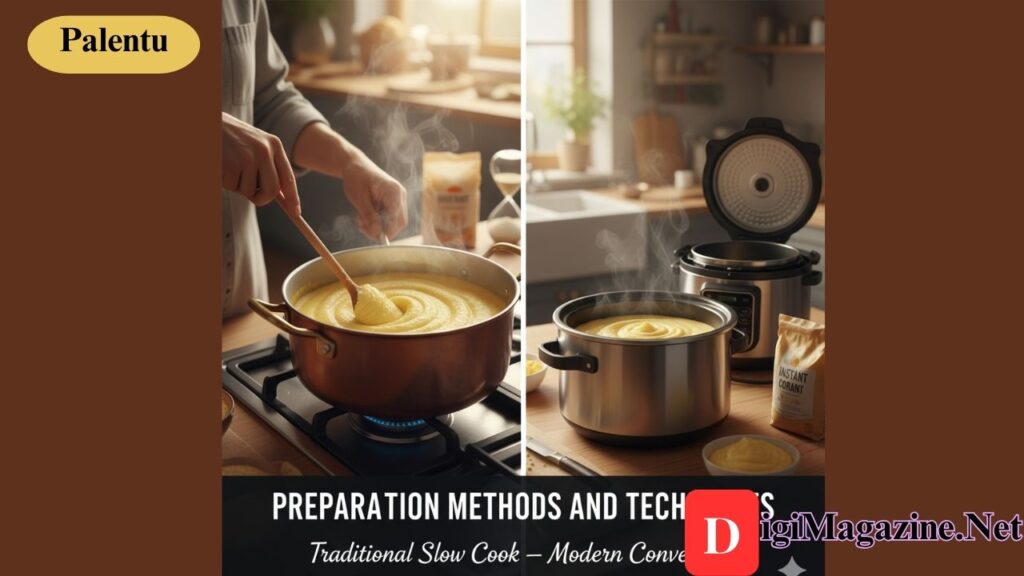Some people mistakenly refer to this traditional dish as “palentu,” possibly confusing it with similar-sounding foods like polenta. While “palentu” might not be the most widely recognized name, it’s a term that has caught on in certain areas to describe a dish that is, in essence, made from cornmeal. This dish is rich in history and remains a staple in various cuisines worldwide. Despite the mix-up in the name, the dish itself has stood the test of time, proving to be both versatile and comforting in kitchens across many cultures.
What Is Palentu?
At its core, palentu is a dish made from cornmeal that is cooked in water, broth, or milk to create a creamy, porridge-like consistency. It’s known for its ability to be either served soft and warm or allowed to cool and solidify, where it can then be sliced and prepared in other ways, such as frying or grilling. The name “palentu” might be used in some regions as a variation of polenta—a popular Italian dish—but it is important to note that the preparation and presentation can differ based on the region.
The beauty of this cornmeal creation lies in its simplicity. With just a few basic ingredients, home cooks can create a satisfying meal that serves as either a main course or a side dish. The texture can range from smooth and creamy to firm and sliceable, depending on the cooking method and the ratio of liquid to cornmeal used during preparation.
The Historical Journey of Cornmeal Dishes

The history of cornmeal-based dishes stretches back centuries, long before the term “palentu” came into use. In ancient times, similar preparations were made with other grains before corn was introduced to Europe from the Americas. Once corn became widely available in the 16th century, it quickly became a staple ingredient for many working-class families due to its affordability and nutritional value.
Throughout different regions, communities developed their own unique ways of preparing cornmeal dishes. Each culture added its own twist, incorporating local ingredients and cooking techniques that reflected its culinary traditions. This adaptability helped the dish survive through generations, evolving to meet the tastes and needs of different populations while maintaining its fundamental character as a hearty, satisfying food.
Essential Ingredients and Variations

The traditional preparation requires only a handful of ingredients, making it accessible to cooks of all skill levels. The primary component is cornmeal, which can be either finely or coarsely ground depending on the desired texture. Some prefer the smooth consistency that comes from fine cornmeal, while others enjoy the rustic, grainy texture of coarser varieties.
The liquid used in cooking plays a crucial role in determining the final flavor profile. Water is the most basic choice, creating a neutral base that allows toppings and accompaniments to shine. Using broth instead adds depth and savory notes, while milk creates a richer, creamier result. Some recipes call for a combination of liquids to achieve the perfect balance of flavor and texture.
Salt is typically the only seasoning added during the cooking process, though some cooks incorporate butter or olive oil for added richness. The simplicity of the ingredient list means that the quality of each component matters greatly, so selecting good cornmeal and using fresh ingredients will make a noticeable difference in the final dish.
Preparation Methods and Techniques

Creating this cornmeal dish requires patience and attention, though the actual process is straightforward. The traditional method involves bringing the liquid to a boil, then gradually whisking in the cornmeal to prevent lumps from forming. Once combined, the mixture is reduced to a gentle simmer and stirred frequently to prevent sticking and ensure even cooking.
The cooking time can vary depending on the grind of the cornmeal and the desired consistency. Fine cornmeal may be ready in about 30 minutes, while coarser varieties can take up to an hour or more. Throughout the cooking process, constant stirring is important to achieve a smooth, creamy texture and prevent the mixture from burning on the bottom of the pot.
For those seeking convenience, instant varieties are available that cook in just a few minutes. While these quick-cooking options lack some of the depth of flavor that comes from slow cooking, they offer a practical solution for busy weeknight meals. Modern cooking methods, such as using a slow cooker or pressure cooker, have also been adapted to make preparation even easier.
Serving Styles and Presentation
One of the most appealing aspects of this dish is its versatility in serving options. When freshly cooked, it can be spooned onto plates while still warm and creamy, creating a comforting base for various toppings. This soft, porridge-like presentation is perfect for breakfast or as a side dish alongside braised meats and stews.
Alternatively, the cooked mixture can be poured into a pan and allowed to cool completely, transforming into a firm, sliceable texture. Once solidified, it can be cut into squares, triangles, or rounds and then fried, grilled, or baked. This preparation method creates a crispy exterior while maintaining a soft, creamy interior—a textural contrast that many find irresistible.
The dish works equally well for breakfast, lunch, or dinner, adapting to whatever role is needed in the meal. In the morning, it might be topped with a drizzle of honey or maple syrup and fresh fruit. At lunch or dinner, it serves as an excellent accompaniment to roasted vegetables, sausages, or rich meat sauces.
Popular Toppings and Accompaniments
The neutral flavor profile makes this cornmeal creation an ideal canvas for a wide variety of toppings and accompaniments. Cheese is perhaps the most common addition, with everything from sharp cheddar to creamy gorgonzola enhancing the dish with salty, tangy notes. Grated parmesan stirred in just before serving creates a luxurious, silky texture.
Meat-based toppings offer heartiness and protein, with options ranging from crispy bacon bits to slow-braised beef or pork ragù. Sausages, whether grilled and sliced or crumbled and sautéed, pair beautifully with the mild cornmeal base. For a lighter option, sautéed mushrooms or roasted vegetables provide earthy flavors and visual appeal.
In some regions, the dish is served with a dollop of yogurt or sour cream, which adds tangy brightness and helps balance richer toppings. Fresh herbs like parsley, basil, or chives can be sprinkled on top for a pop of color and fresh flavor. The possibilities for customization are nearly endless, limited only by imagination and personal preference.
Nutritional Benefits and Dietary Considerations
From a nutritional standpoint, cornmeal dishes offer several advantages. Corn is naturally gluten-free, making this an excellent option for those with celiac disease or gluten sensitivity. It provides complex carbohydrates that deliver sustained energy throughout the day, making it particularly satisfying as a breakfast or pre-activity meal.
Cornmeal contains dietary fiber, which supports digestive health and helps maintain steady blood sugar levels. It also provides essential minerals like iron and magnesium, along with B vitamins that support metabolism and energy production. The nutritional profile can be enhanced by choosing whole-grain cornmeal, which retains more of the corn’s natural nutrients.
The healthfulness of the final dish depends largely on how it’s prepared and what it’s served with. When cooked simply with water and minimal salt, it remains a relatively low-calorie, wholesome food. However, additions like butter, cream, cheese, and fatty meats will increase the calorie and fat content. For those watching their diet, balancing indulgent toppings with plenty of vegetables creates a more nutritious meal.
Cultural Significance Across Regions
Throughout various cultures, this cornmeal dish holds special significance beyond its role as everyday food. In many families, the recipe has been passed down through generations, with each cook adding their own special touches while maintaining the essential character of the dish. These family traditions create connections to heritage and provide a tangible link to ancestors who prepared the same meal in their own kitchens.
In certain regions, the dish plays a central role in celebrations and festivals. Community gatherings often feature large pots of the cornmeal creation, served to crowds of people and enjoyed as part of the festivities. The act of preparing and sharing the food becomes a way of strengthening social bonds and maintaining cultural identity.
As culinary trends continue to evolve, this traditional dish has found new appreciation among food enthusiasts and professional chefs. Upscale restaurants have begun featuring refined versions on their menus, introducing the humble cornmeal preparation to diners who might never have encountered it otherwise. This renewed interest helps ensure that the dish will continue to be enjoyed for generations to come.
Modern Interpretations and Innovations
Contemporary cooks have embraced this traditional dish while adding modern twists that reflect current food trends. Some chefs experiment with flavored varieties, incorporating ingredients like roasted garlic, sun-dried tomatoes, or fresh herbs directly into the cornmeal during cooking. These additions create interesting flavor profiles while maintaining the dish’s essential character.
Others have explored using different types of cornmeal or alternative grains altogether, creating fusion versions that blend culinary traditions. Blue cornmeal, for instance, adds visual interest and a slightly different flavor profile. Some innovative recipes even combine cornmeal with other grain flours to create unique textures and nutritional benefits.
The presentation of the dish has also evolved in restaurant settings, where chefs might create elegant towers, delicate rounds, or artistic shapes that elevate the humble preparation to fine dining status. Despite these modern innovations, the core appeal of the dish remains unchanged—it’s a comforting, satisfying food that brings people together around the table.
Tips for Perfect Results Every Time
Achieving the ideal texture and flavor requires attention to a few key details. First, always add the cornmeal to the liquid gradually while whisking constantly to prevent lumps from forming. If lumps do appear, they can often be smoothed out with vigorous stirring or by using an immersion blender.
The ratio of liquid to cornmeal is crucial for determining the final consistency. For a creamy, spoonable result, use a ratio of about four parts liquid to one part cornmeal. For a firmer texture that will hold its shape when sliced, reduce the liquid to about three parts liquid to one part cornmeal. These ratios can be adjusted based on personal preference and how the dish will be served.
Don’t rush the cooking process. Low and slow is the key to developing the best flavor and achieving a smooth, creamy texture without grittiness. Frequent stirring prevents burning and ensures even cooking throughout. If the mixture becomes too thick before it’s fully cooked, additional liquid can be stirred in gradually to reach the desired consistency.
Storage and Reheating
Leftover cornmeal preparations store well and can be enjoyed for several days after cooking. Once cooled, the dish should be transferred to an airtight container and refrigerated, where it will keep for up to five days. The texture will firm up considerably as it cools, which is actually desirable if planning to slice and fry it later.
Reheating soft, creamy leftovers can be done on the stovetop or in the microwave. Add a splash of water, broth, or milk to help restore the creamy consistency, as the cornmeal will have absorbed moisture during storage. Stir frequently while heating to ensure even warming and to prevent the mixture from drying out or developing a skin on top.
For solidified portions that were intended for frying or grilling, there’s no need to reheat before cooking. Simply slice the cold block into the desired shapes and proceed with frying or grilling as planned. The contrast between the crispy exterior and creamy interior will be just as delicious as freshly prepared.
Conclusion
Whether known as palentu or by any other name, this cornmeal dish represents comfort food at its finest. Its long history, cultural significance, and remarkable versatility have earned it a permanent place in kitchens around the world. From humble peasant food to refined restaurant fare, the dish has proven its ability to adapt and thrive across different contexts and time periods.
The simple ingredient list and straightforward preparation make it accessible to cooks of all experience levels, while the endless possibilities for customization ensure that it never becomes boring. Whether served soft and creamy or firm and crispy, topped with simple butter or elaborate sauces, this cornmeal creation continues to bring satisfaction and comfort to those who prepare and enjoy it.
As food traditions continue to evolve and blend across cultures, dishes like this one serve as reminders of our shared culinary heritage. They demonstrate how basic ingredients, prepared with care and shared with others, can create meaningful connections and lasting memories. For anyone who hasn’t yet experienced this traditional dish, there’s no better time to discover why it has remained beloved for generations.
For more information, visit Digi Magazine.







